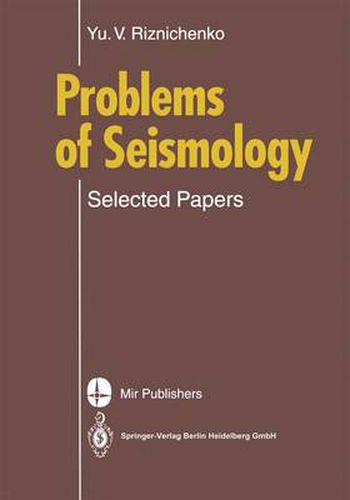Readings Newsletter
Become a Readings Member to make your shopping experience even easier.
Sign in or sign up for free!
You’re not far away from qualifying for FREE standard shipping within Australia
You’ve qualified for FREE standard shipping within Australia
The cart is loading…






This title is printed to order. This book may have been self-published. If so, we cannot guarantee the quality of the content. In the main most books will have gone through the editing process however some may not. We therefore suggest that you be aware of this before ordering this book. If in doubt check either the author or publisher’s details as we are unable to accept any returns unless they are faulty. Please contact us if you have any questions.
This volume is a selection of the most significant papers Yu,V. Riz nichenko wrote during his 30-year career and concerns the development of fundamental problems of seismology. The book is in five parts. The first is devoted to source seismicity. It starts with a chapter on the elementary unit of seismicity, viz. the earthquake source. The size of an earthquake is in itself a significant problem in seismology and, is discussed here. The main energetic parameters of the source are consi dered, namely, seismic energy, magnitude, seismic moment, geometric size of the main fault, displacements along the fault, and stress drop. The main results of comparison, mutual adjustment and correlations between these parameters are presented. The following chapters are a logical continuation of the first: from an individual earthquake source to a set of earthquakes in space and time, viz. a seismic regime. The chapters convey the now classical principles of seismic regime parametrization and mapping techniques for long-term average seismic activity based on basic principles. How to determine the maximum possible earthquake is a central question. Both the theoretical (or gnostic) and practical i.e. seismic zon ing, aspects are considered. Methods of determining and mapping the maximum possible earthquakes are proposed, in particular, by correlating them with seismic activity and, in general, from seismological and other geophysical, geological, geomorphological and geodetical data sets.
$9.00 standard shipping within Australia
FREE standard shipping within Australia for orders over $100.00
Express & International shipping calculated at checkout
This title is printed to order. This book may have been self-published. If so, we cannot guarantee the quality of the content. In the main most books will have gone through the editing process however some may not. We therefore suggest that you be aware of this before ordering this book. If in doubt check either the author or publisher’s details as we are unable to accept any returns unless they are faulty. Please contact us if you have any questions.
This volume is a selection of the most significant papers Yu,V. Riz nichenko wrote during his 30-year career and concerns the development of fundamental problems of seismology. The book is in five parts. The first is devoted to source seismicity. It starts with a chapter on the elementary unit of seismicity, viz. the earthquake source. The size of an earthquake is in itself a significant problem in seismology and, is discussed here. The main energetic parameters of the source are consi dered, namely, seismic energy, magnitude, seismic moment, geometric size of the main fault, displacements along the fault, and stress drop. The main results of comparison, mutual adjustment and correlations between these parameters are presented. The following chapters are a logical continuation of the first: from an individual earthquake source to a set of earthquakes in space and time, viz. a seismic regime. The chapters convey the now classical principles of seismic regime parametrization and mapping techniques for long-term average seismic activity based on basic principles. How to determine the maximum possible earthquake is a central question. Both the theoretical (or gnostic) and practical i.e. seismic zon ing, aspects are considered. Methods of determining and mapping the maximum possible earthquakes are proposed, in particular, by correlating them with seismic activity and, in general, from seismological and other geophysical, geological, geomorphological and geodetical data sets.